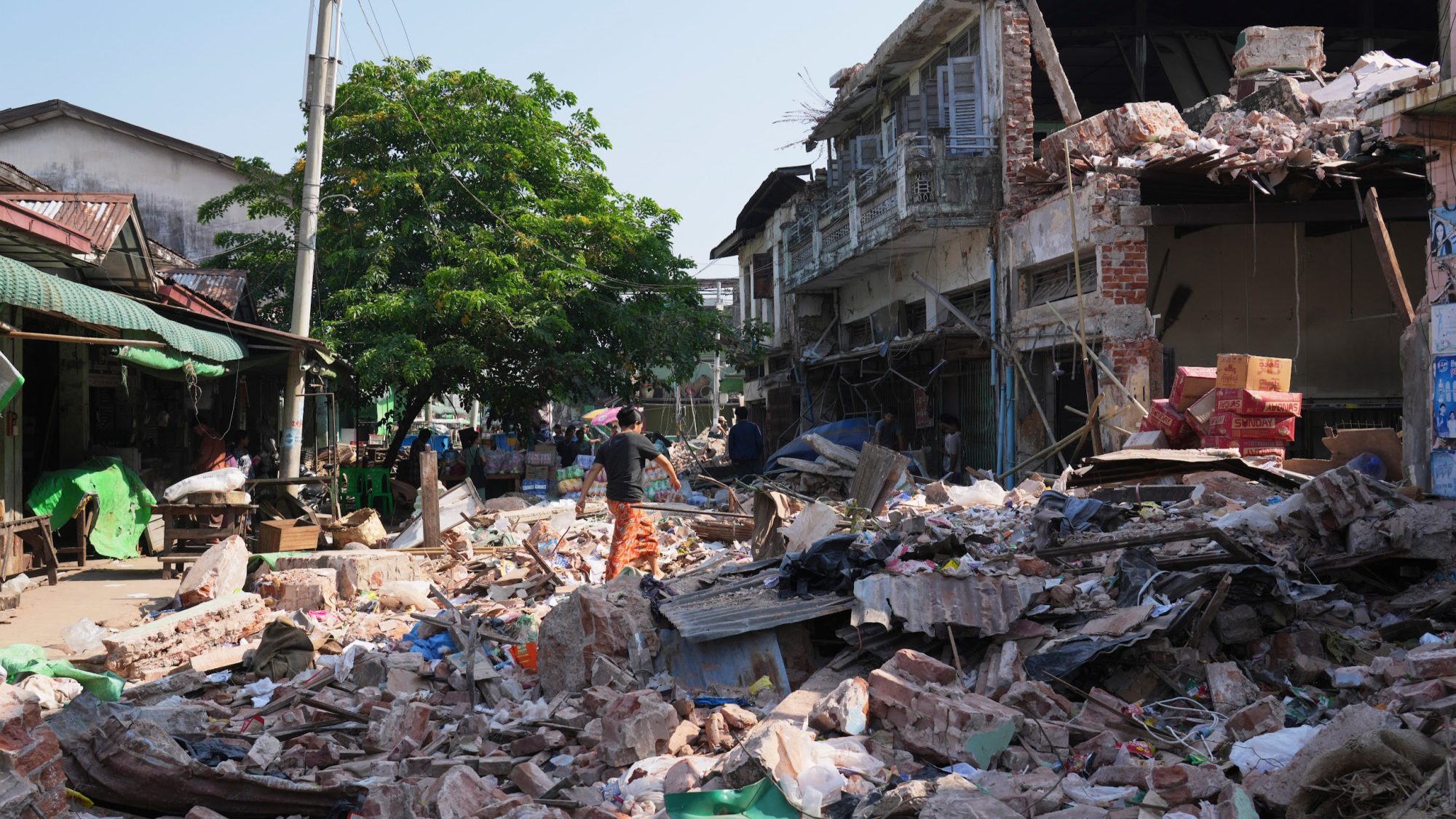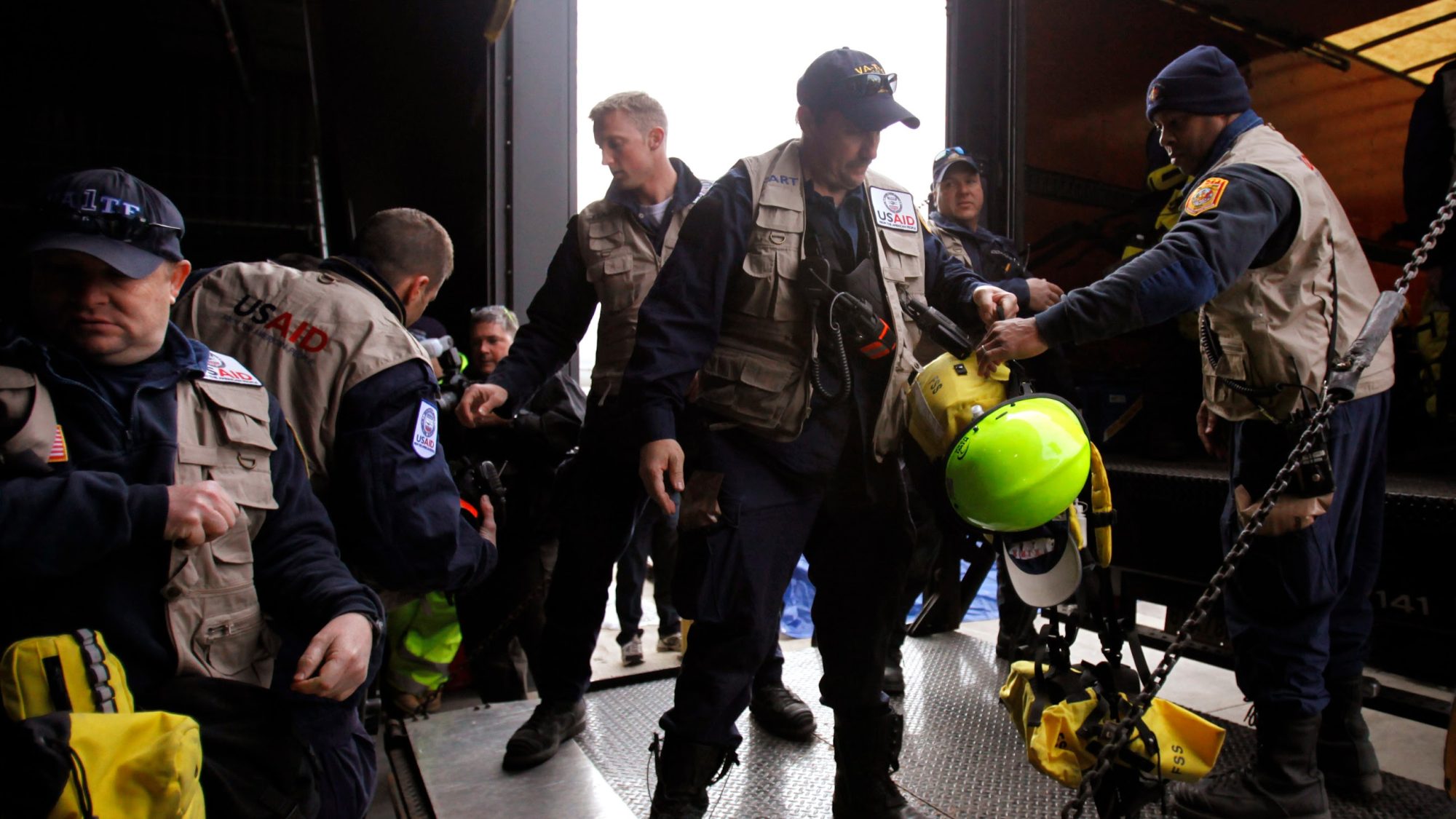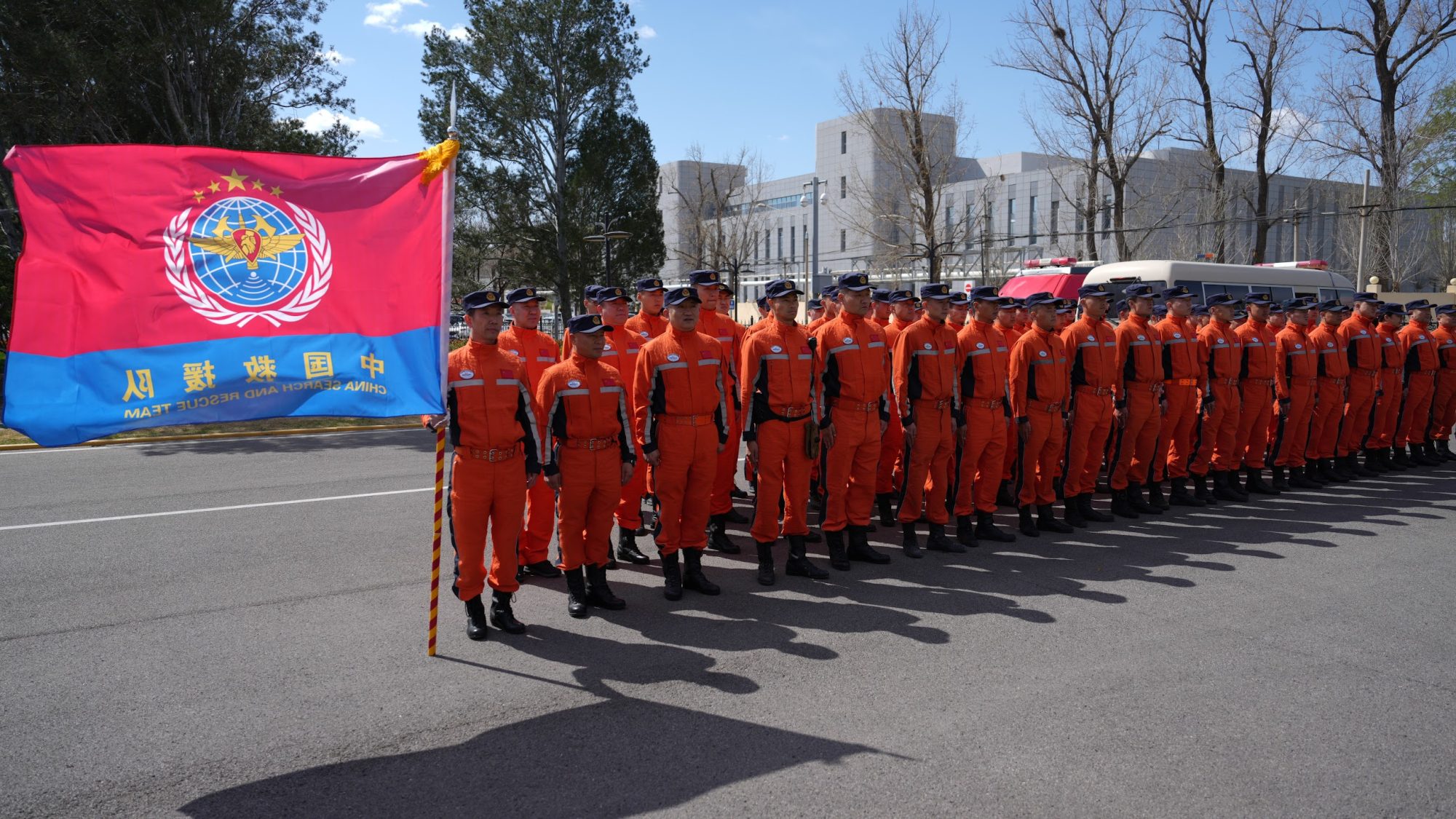Without USAID, Myanmar Is Struggling to Recover From Its Massive Earthquake

Chinese rescuers pulled a pregnant survivor from the rubble in Mandalay, Myanmar on Monday morning.Zhang Dongqiang/Xinhua/ZUMA
Chris Milligan arrived in Myanmar in 2012 with a mandate: Help repair diplomatic relations with the southeast Asian country by reopening its United States Agency for International Development (USAID) mission.
By that point, Milligan had worked for the USAID for more than two decades—a tenure that included working on reconstruction in Baghdad following the Iraq War and coordinating the recovery response to Haiti’s devastating 2010 earthquake. His Myanmar assignment posed a similarly significant challenge: After decades spent under brutal military rule, the country was in the midst of trying to transition to democracy.
Reopening the USAID mission in Myanmar, at the American embassy in the city of Yangon, was meant to facilitate that process by helping “reestablish [Myanmar’s] capacity to feed its people and to care for its sick, and educate its children, and build its democratic institutions,” former President Barack Obama said during his 2012 visit to the country—the first by a US president.
According to Milligan, the efforts the mission ultimately pursued in Myanmar—such as providing humanitarian assistance, working with local groups to facilitate peace talks, supporting farmers, and partnering with local health organizations to combat diseases—“were really all designed to strengthen the democratic and economic reforms that were ongoing in the country.”
Fast forward to now, and that progress has been decimated, with USAID missions shuttered around the world after the Trump administration reportedly fired all but 15 legally required positions of the agency’s global staff, throwing it into chaos.
In Myanmar—where a civil war has been raging since 2021, when the country plunged back into military rule—the significance of the cuts to USAID is becoming devastatingly clear, as the country reels from the 7.7-magnitude earthquake that hit Friday, killing at least 2,700 people and leaving more than 3,900 injured, according to Myanmar officials. (The US Geological Survey estimates fatalities are actually north of 10,000, and that the economic losses could exceed the country’s GDP.) There are no US officials currently on the ground, and the New York Times reports that a three-person USAID team is not expected to arrive until Wednesday, citing a source with knowledge of the deployment efforts. Even before the earthquake, there were nearly 20 million people in the country in need of humanitarian assistance, a UN official has said.

On Sunday, the US Embassy in Myanmar announced that the American government would provide up to $2 million towards recovery efforts—an amount that Milligan says is paltry compared to prior support for similar natural disasters, like the more than $2 billion USAID committed to recovery efforts in the decade after the 2010 quake in Haiti. On Monday, State Department spokesperson Tammy Bruce told reporters at a press briefing she rejected the notion that USAID cuts were impacting the earthquake response, claiming, “people are on the ground,” and then confusingly adding, “I would reject the premise that the sign of success is that we are physically there.” The State Department did not respond to questions from Mother Jones for this story.
I spoke with Milligan, who retired from USAID in 2021, via Zoom on Tuesday about the inadequacy of the US response to the earthquake recovery and its impacts on citizens of Myanmar; how the absence of American forces on the ground could give China and Russia a geopolitical edge; and how the recovery effort would be different if USAID were still intact.
This interview has been lightly condensed and edited for clarity.
The State Department claims the cuts to USAID have not impacted their ability to assist with recovery efforts on the ground in Myanmar. Is this plausible?
When you dismantle an entire bureau of thousands of people who provide humanitarian assistance, no, it’s not plausible that there’s no impact on the US government’s authority to provide humanitarian assistance. And what we’re seeing is that impact.
At this stage normally, we would have a disaster assistance response team (DART) on the ground. The initial wave of experts would be on the ground within hours, and then the DART would then grow. So, for example, following the 2023 earthquake in Turkey, we had a DART of 200 people on the ground; 160 of them were search and rescue individuals.
By now, we would have a search and rescue team of hundreds of people on the ground in Myanmar, digging people out of rubble. Now all we’re told is, ‘we may be able to send three people there.’
USAID still maintains humanitarian assistance advisors, who have a specialty in the overall establishment of humanitarian assistance. But the provision of humanitarian assistance requires highly developed technical skills: You need someone who knows all about potable water and child protection; you need security; you need shelter experts; you need communication experts; you need food security experts. That’s why the DART is full of these experts who have careers in delivering this kind of assistance.
So to say that’s been replaced by three people and $2 million is ludicrous. Meanwhile, China and Russia and others have scrambled with larger teams. They’re actually providing the support that’s required, but it’s not filling the gap of what we would do with a team of 200 people on the ground.

Help contextualize the $2 million American officials said they will provide to Myanmar for recovery—is it adequate, and how does it compare to how the US previously responded to natural disasters like this, in Myanmar or elsewhere?
This is not adequate. Generally, the US government makes a small pledge, and then builds upon the pledge. So hopefully, the $2 million is seed money, and then there’ll be more funding forthcoming.
The scale of assistance can vary. On one hand, the response to the devastating earthquake in Haiti in 2010—in which we scrambled and provided enormous assistance to the 1.4 million people who were displaced and who needed food and shelter and help—was about a billion dollars within six months. The support we provided following the 2008 Cyclone Nargis—Myanmar’s worst natural disaster in history, which killed more than 80,000 people—was $196 million over the following four years.
So $2 million is not going to have much of an impact at all, and it fails by comparison, because we know that China is already at $14 million. The world is wondering why the country with the most developed expertise, that has the capacity, that has the resources, isn’t stepping up and helping at this time.
I know you worked on the earthquake response in Haiti for USAID. What are the challenges that a place like Haiti, or Myanmar, have in responding to an earthquake, and what role did foreign assistance from USAID typically play in rebuilding?
Although no two disasters are the same, they do follow similar processes. What you want to do initially is save lives. You want to get people out of rubble, you want to provide emergency shelter, water, food, health care. Secondly, you want to avoid a second rate of death that comes from the spread of diseases, cholera, lack of food. You want to avoid conflict over scarce resources. So there is a rhythm to a response: immediate life saving, relief, recovery, and then finally, back to development. It’s a continuum shared between Haiti or Myanmar, even though the context is always different.

In Myanmar, you have no central government, really. You have a brutal civil war. It’s more difficult for a national level response. Not only were transportation networks destroyed by the earthquake, they’ve been destroyed by the civil war, and you can’t freely move goods across the country because different territories and land are held by different factions.
It’s very difficult to mobilize international support that’s needed to rebuild and recover because of the lack of a legitimate government to work with.
I wanted to ask you about China and Russia, given reports that they are among the countries that have sent teams of people to Myanmar to help rescue people from the rubble and assist with on-the-ground recovery. What impacts could their assistance have on building their soft power in the region and undermining US interests?
The United States government provides humanitarian assistance based upon need, not on politics. However, there are enormous dividends to doing so. First of all, it showcases American values of generosity and compassion. It links America directly to communities overseas. It creates enormous goodwill. It increases our diplomatic power as well.
China already is the major trading power for 120 countries around the world. It’s one of the largest creditor nations in the world. So it has stronger and deeper economic ties to most countries in the world than the United States does. By getting rid of the economic work that USAID does, we’re strengthening China’s economic ties with the world, and by walking away from the work that we do, we’re creating a political vacuum that China is filling.

China needs a world that looks like China. That’s what countries do: they work in their own national interest. The work that we do to build stable, safe, prosperous democracy overseas has all stopped. The support we provide to human rights actors has stopped. The support we provide for free press, free information, has stopped. China will take advantage of this to conform the world for its own benefit at our cost.
The location of the USAID mission is in Yangon, which is the southern part of the country, not in proximity to the earthquake. Certainly they felt the shocks, but the destruction was in the second largest city further north, Mandalay, and then more disruption in the capital Naypyidaw. I’ve been in touch to share my concerns with people there. Very few of them have been able to travel to the earthquake zone. The American staff have all received their termination letters, and the administration has notified Congress that it will be terminating all the local hires as well.
These local hires have spent decades, some of them, working for USAID and the US government, and they’re just going to be let go and dropped—and they will be in a risky situation, because the military government knows who they are and what they’ve been doing. We are going to turn our backs on those who serve the United States government and also serve their own country by trying to bring reforms to it.
How do you think the US response would differ if USAID was still intact? How would things look different on the ground?
If USAID were still intact, we would have a large disaster assistance response team on the ground. We would have mobilized urban search and rescue teams from Los Angeles County and Fairfax County, Virginia; they would be there with the sniffer dogs and the equipment necessary to pull people out of the rubble. We would have experts—in nutrition, food, water, shelter, protection—on the ground; they would be working with the other donors to find out where the needs are, where are the gaps, and how the United States government can best help. We would be supporting the international coordination effort, which would be led by the UN but with our support. And so what you would have is a more robust international effort, and you’d ultimately be saving more lives.
We have the capacity, we have the ability, and we have the assets to save lives, and the choice has been not to use it, and people are dying.